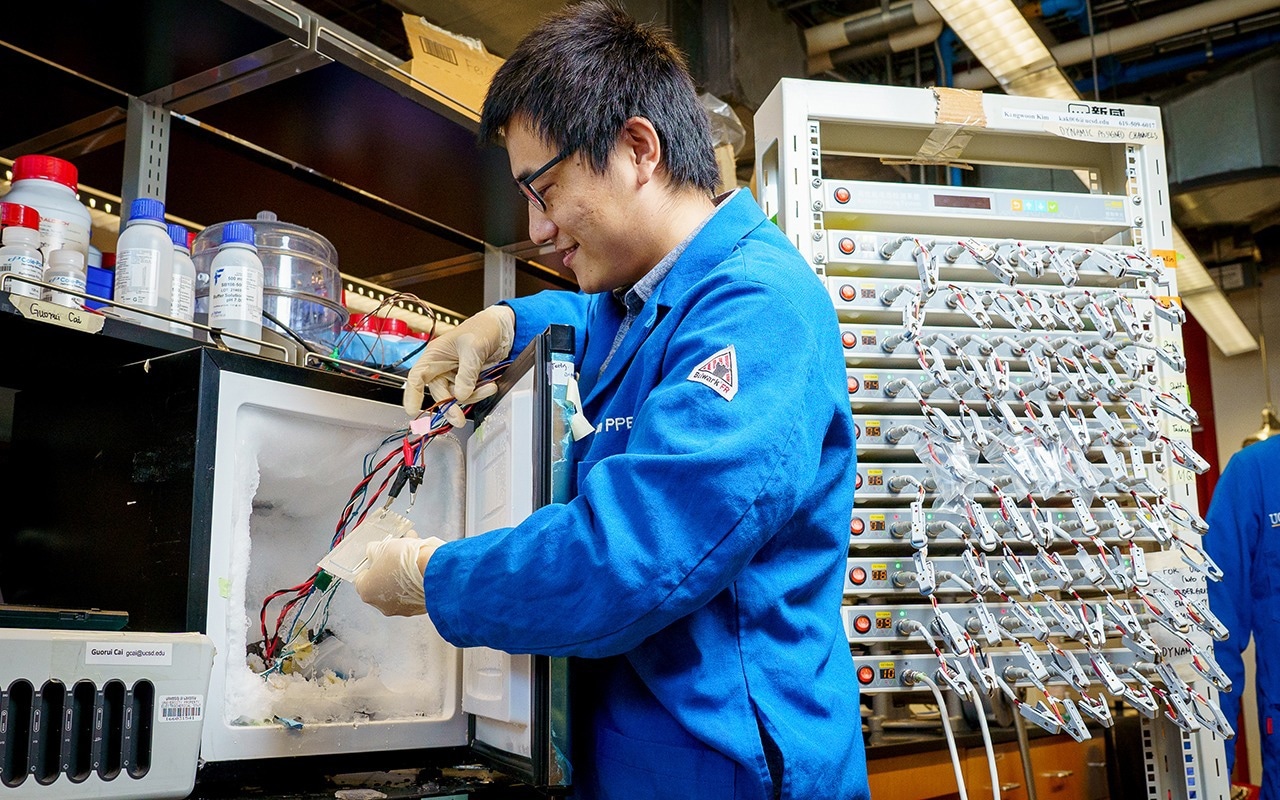Engineers at the University of California, San Diego, have created lithium-ion batteries that function well in both freezing cold and scorching hot temperatures while storing a significant amount of energy. The scientists achieved this by creating an electrolyte that is not only flexible and sturdy across a wide range of temperatures, but also consistent with a high-energy anode and cathode.
 Study first author Guorui Cai, a nanoengineering postdoctoral researcher at UC San Diego, prepares a battery pouch cell for testing at subfreezing temperature. Image Credit: David Baillot/UC San Diego Jacobs School of Engineering.
Study first author Guorui Cai, a nanoengineering postdoctoral researcher at UC San Diego, prepares a battery pouch cell for testing at subfreezing temperature. Image Credit: David Baillot/UC San Diego Jacobs School of Engineering.
The temperature-resilient batteries are characterized in a paper published the week of July 4th, 2022, in the Proceedings of the National Academy of Sciences (PNAS).
According to Zheng Chen, a professor of nanoengineering at the UC San Diego Jacobs School of Engineering and senior author of the study, such batteries could permit electric vehicles in cold climates to travel further with just a single charge. They could also reduce the requirement of cooling systems to keep the vehicles’ battery packs from overheating in hot climates.
You need high-temperature operation in areas where the ambient temperature can reach the triple digits and the roads get even hotter. In electric vehicles, the battery packs are typically under the floor, close to these hot roads.
Zheng Chen, Study Senior Author and Professor, Nanoengineering, Jacobs School Of Engineering, UC San Diego
Chen was also a faculty member of the UC San Diego Sustainable Power and Energy Center.
“Also, batteries warm up just from having a current run through during operation. If the batteries cannot tolerate this warmup at high temperature, their performance will quickly degrade.”
The actual evidence of batteries maintained 87.5% and 115.9% of their energy capacity in tests at -40 and 50 °C (-40 and 122 °F), respectively. They also had elevated Coulombic efficiencies of 98.2% and 98.7% at these temperatures, indicating that the batteries can withstand more charge and discharge loops before failing.
Due to their electrolyte, Chen’s batteries are both cold and heat resilient. It is composed of a dibutyl ether liquid solution blended with a lithium salt. Dibutyl ether has a unique property in that its molecules only weakly connect to lithium ions. In other words, as the battery runs, the electrolyte molecules easily release lithium ions.
In an earlier study, scientists found that this weak molecular interaction improves battery performance at sub-zero temperatures. Furthermore, dibutyl ether can withstand high temperatures because it remains liquid at high temperatures (it has a boiling point of 141 °C or 286 °F).
Stabilizing Lithium-Sulfur Chemistries
This electrolyte is also unique in that it is consistent with a lithium-sulfur battery, which is a type of rechargeable battery with a lithium metal anode and a sulfur cathode. As they guarantee higher energy densities and reduced costs, lithium-sulfur batteries are an integral part of next-generation battery technologies.
They can hold up to twice as much energy per kilogram as today’s lithium-ion batteries, potentially doubling the range of electric vehicles without increasing battery pack weight. Furthermore, sulfur is more plentiful and less difficult to obtain than cobalt, which is used in conventional lithium-ion battery cathodes.
However, there are issues with lithium-sulfur batteries. The cathode and anode are both extremely reactive. Sulfur cathodes are so reactive that they dissolve while the battery is running. This problem worsens in hot weather.
Furthermore, lithium metal anodes are susceptible to forming needle-like structures known as dendrites, which can penetrate parts of the battery and cause a short circuit. Lithium-sulfur batteries have a limited lifespan of tens of cycles.
If you want a battery with high energy density, you typically need to use very harsh, complicated chemistry. High energy means more reactions are happening, which means less stability, and more degradation. Making a high-energy battery that is stable is a difficult task itself—trying to do this through a wide temperature range is even more challenging.
Zheng Chen, Study Senior Author and Professor, Nanoengineering, Jacobs School Of Engineering, UC San Diego
The UC San Diego team’s dibutyl ether electrolyte restricts these problems at both high and low temperatures. They discovered that the batteries they evaluated had significantly longer cycling lives than just a typical lithium-sulfur battery.
“Our electrolyte helps improve both the cathode side and anode side while providing high conductivity and interfacial stability,” said Chen.
The team also improved the stability of the sulfur cathode by grafting it to a polymer. This prevents further sulfur dissolution into the electrolyte.
The battery chemistry will then be scaled up, optimized to work at even higher temperatures, and cycle life will be extended even further.